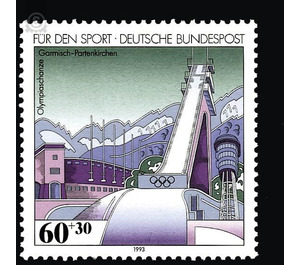sport aid - Germany / Federal Republic of Germany 1993 - 60 Pfennig
Theme: Architecture
| Country | Germany / Federal Republic of Germany |
| Issue Date | 1993 |
| Face Value | 60.00 |
| Color | green |
| Perforation | K 13 3/4 |
| Printing Type | Multicolor offset printing |
| Stamp Type | Postage stamp |
| Item Type | Stamp |
| Chronological Issue Number | 1523 |
| Chronological Chapter | GER-BRD |
| SID | 857711 |
| In 29 Wishlists | |
The realization of large ski jumping events has always been the great passion of the Ski Club Partenkirchen. Christmas and New Year ski jumping, night ski jumping, cup jumping, all kinds of championships were and are held on the existing jump facilities in the Olympic Ski Stadium, the sporting center of the Ski Club Partenkirchen, with great success. The biggest event in ski jumping in the history of Ski Club Partenkirchen was, of course, the Olympic Special Jumping on the "big ones" at the conclusion of the 1936 Games, which was attended by 130,000 spectators at the stadium. It all started with the legendary Kochelberg ski jump, which was officially inaugurated on 4 February 1925 with a German record of 55 meters, and where, twelve days later, the Norwegian Ljungmann set a new world record of 59.5 meters, which lasted for five years , The ski jumping hill on Gudiberg - where today the Olympic ski stadium is located - was named "Olympic ski jump on the Gudiberg" on the occasion of the Christmas ski jumping in 1922, without those responsible for suspecting that the Olympic Winter Games were actually held there 13 years later. After the allocation of the games to the new twin town of Garmisch-Partenkirchen in 1933 by the IOC Congress in Athens, the construction of the Olympic ski jumping hill started immediately, which was inaugurated on 5 February 1934. After the 36er-Spiele the entire Skistadion was renewed, because there the Olympic Games should be discharged 1940. The large Olympic ski lodge itself was adapted to the latest findings through several renovations and new buildings; Thus in 1950 a inrun tower was built in all-steel construction and in 1955 the judges tower was renewed. In 1978, the current plant was finally handed over to the public.


